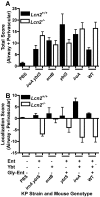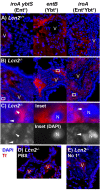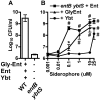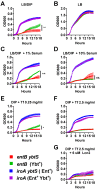Interaction of lipocalin 2, transferrin, and siderophores determines the replicative niche of Klebsiella pneumoniae during pneumonia
- PMID: 23169997
- PMCID: PMC3509427
- DOI: 10.1128/mBio.00224-11
Interaction of lipocalin 2, transferrin, and siderophores determines the replicative niche of Klebsiella pneumoniae during pneumonia
Abstract
Pathogenic bacteria require iron for replication within their host. Klebsiella pneumoniae and other Gram-negative pathogens produce the prototypical siderophore enterobactin (Ent) to scavenge iron in vivo. In response, mucosal surfaces secrete lipocalin 2 (Lcn2), an innate immune protein that binds Ent to disrupt bacterial iron acquisition and promote acute inflammation during colonization. A subset of K. pneumoniae isolates attempt to evade Lcn2 by producing glycosylated Ent (Gly-Ent, salmochelin) or the alternative siderophore yersiniabactin (Ybt). However, these siderophores are not functionally equivalent and differ in their abilities to promote growth in the upper respiratory tract, lungs, and serum. To understand how Lcn2 exploits functional differences between siderophores, isogenic mutants of an Ent(+) Gly-Ent(+) Ybt(+) K. pneumoniae strain were inoculated into Lcn2(+/+) and Lcn2(-/-) mice, and the pattern of pneumonia was examined. Lcn2 effectively protected against the iroA ybtS mutant (Ent(+) Gly-Ent(-) Ybt(-)). Lcn2(+/+) mice had small foci of pneumonia, whereas Lcn2(-/-) mice had many bacteria in the perivascular space. The entB mutant (Ent(-) Ybt(+) Gly-Ent(-)) caused moderate bronchopneumonia but did not invade the transferrin-containing perivascular space. Accordingly, transferrin blocked Ybt-dependent growth in vitro. The wild type and the iroA mutant, which both produce Ent and Ybt, had a mixed phenotype, causing a moderate bronchopneumonia in Lcn2(+/+) mice and perivascular overgrowth in Lcn2(-/-) mice. Together, these data indicate that Lcn2, in combination with transferrin, confines K. pneumoniae to the airways and prevents invasion into tissue containing the pulmonary vasculature.
Importance: Gram-negative bacteria are a common cause of severe hospital-acquired infections. To cause disease, they must obtain iron and secrete the small molecule enterobactin to do so. Animal models of pneumonia using Klebsiella pneumoniae indicate that enterobactin promotes severe disease. Accordingly, the host defense protein lipocalin 2 exploits this common target by binding enterobactin and disrupting its function. However, pathogenic bacteria often make additional siderophores that lipocalin 2 cannot bind, such as yersiniabactin, which could make this host defense ineffective. This work compares the pattern and severity of pneumonia caused by K. pneumoniae based on which siderophores it produces. The results indicate that enterobactin promotes growth around blood vessels that are rich in the iron-binding protein transferrin, but yersiniabactin does not. Together, transferrin and lipocalin 2 protect this space against all types of K. pneumoniae tested. Therefore, the ability to acquire iron determines where bacteria can grow in the lung.
Figures






Similar articles
-
Klebsiella pneumoniae yersiniabactin promotes respiratory tract infection through evasion of lipocalin 2.Infect Immun. 2011 Aug;79(8):3309-16. doi: 10.1128/IAI.05114-11. Epub 2011 May 16. Infect Immun. 2011. PMID: 21576334 Free PMC article.
-
Mucosal lipocalin 2 has pro-inflammatory and iron-sequestering effects in response to bacterial enterobactin.PLoS Pathog. 2009 Oct;5(10):e1000622. doi: 10.1371/journal.ppat.1000622. Epub 2009 Oct 16. PLoS Pathog. 2009. PMID: 19834550 Free PMC article.
-
Bacterial siderophores that evade or overwhelm lipocalin 2 induce hypoxia inducible factor 1α and proinflammatory cytokine secretion in cultured respiratory epithelial cells.Infect Immun. 2014 Sep;82(9):3826-36. doi: 10.1128/IAI.01849-14. Epub 2014 Jun 30. Infect Immun. 2014. PMID: 24980968 Free PMC article.
-
Iron metabolism at the host pathogen interface: lipocalin 2 and the pathogen-associated iroA gene cluster.Int J Biochem Cell Biol. 2007;39(10):1776-80. doi: 10.1016/j.biocel.2007.07.003. Epub 2007 Jul 18. Int J Biochem Cell Biol. 2007. PMID: 17714976 Free PMC article. Review.
-
Neutrophil gelatinase-associated lipocalin, a siderophore-binding eukaryotic protein.Biometals. 2006 Apr;19(2):211-5. doi: 10.1007/s10534-005-3251-7. Biometals. 2006. PMID: 16718606 Review.
Cited by
-
Microenvironmental Factors that Shape Bacterial Metabolites in Inflammatory Bowel Disease.Front Cell Infect Microbiol. 2022 Jul 15;12:934619. doi: 10.3389/fcimb.2022.934619. eCollection 2022. Front Cell Infect Microbiol. 2022. PMID: 35959366 Free PMC article. Review.
-
Various arrangements of mobile genetic elements among CC147 subpopulations of Klebsiella pneumoniae harboring blaNDM-1: a comparative genomic analysis of carbapenem resistant strains.J Biomed Sci. 2023 Aug 25;30(1):73. doi: 10.1186/s12929-023-00960-0. J Biomed Sci. 2023. PMID: 37626377 Free PMC article.
-
Buried Treasure: Evolutionary Perspectives on Microbial Iron Piracy.Trends Genet. 2015 Nov;31(11):627-636. doi: 10.1016/j.tig.2015.09.001. Epub 2015 Sep 29. Trends Genet. 2015. PMID: 26431675 Free PMC article. Review.
-
Klebsiella pneumoniae infection biology: living to counteract host defences.FEMS Microbiol Rev. 2019 Mar 1;43(2):123-144. doi: 10.1093/femsre/fuy043. FEMS Microbiol Rev. 2019. PMID: 30452654 Free PMC article. Review.
-
Integrative Physiology of Pneumonia.Physiol Rev. 2018 Jul 1;98(3):1417-1464. doi: 10.1152/physrev.00032.2017. Physiol Rev. 2018. PMID: 29767563 Free PMC article. Review.
References
-
- Earhart CF. 1996. Uptake and metabolism of iron and molybdenum. In Neidhart F, E. coli and salmonella. ASM Press, Washington, DC
-
- Nairz M, Schroll A, Sonnweber T, Weiss G. 2010. The struggle for iron—a metal at the host-pathogen interface. Cell. Microbiol. 12:1691–1702 - PubMed
-
- Skaar EP. 2010. The battle for iron between bacterial pathogens and their vertebrate hosts. PLoS Pathog. 6:e1000949 http://dx.doi.org/doi:10.1371/journal.ppat.1000949 - PMC - PubMed
Publication types
MeSH terms
Substances
Grants and funding
LinkOut - more resources
Full Text Sources
Other Literature Sources
Molecular Biology Databases
Research Materials
Miscellaneous

